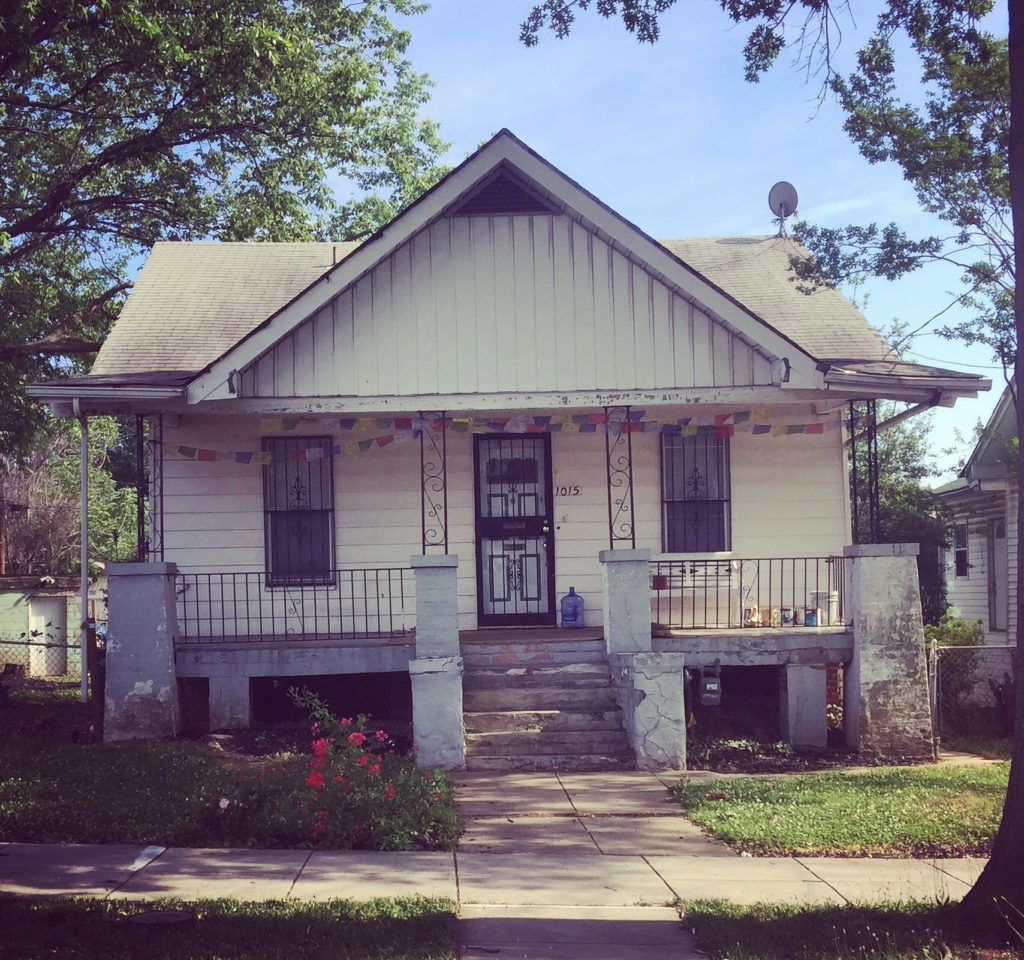The Mousai House: A Cooperative Vision for a New Creative Economy
PARADIGM CHANGES, 25 Jul 2016
Jennifer Bryant | The Next System Project – TRANSCEND Media Service
 30 Jun 2016 – We asked Jennifer Bryant—a DC-based writer, organizer and radio host—to highlight an emblematic example pointing towards what Dr. Jessica Gordon Nembhard calls a cooperative solidarity commonwealth, which she details in her essay in Volume 2 of our “New Systems: Possibilities and Proposals” series. Bryant’s exposition of The Mousai House gives us a glimpse into a thriving local economy rooted in Washington D.C. that has blossomed despite struggle, displacement, and oppression, exemplifying a rich cooperative culture that transcends the current system.
30 Jun 2016 – We asked Jennifer Bryant—a DC-based writer, organizer and radio host—to highlight an emblematic example pointing towards what Dr. Jessica Gordon Nembhard calls a cooperative solidarity commonwealth, which she details in her essay in Volume 2 of our “New Systems: Possibilities and Proposals” series. Bryant’s exposition of The Mousai House gives us a glimpse into a thriving local economy rooted in Washington D.C. that has blossomed despite struggle, displacement, and oppression, exemplifying a rich cooperative culture that transcends the current system.
Washington, DC is a city full of monuments. Some are fashioned from marble and stone. Some exist only in the minds and memories of everyday people. All of them preserve histories of crisis and triumph. This is the story of one of the District’s hidden monuments.
In 1975, the band Parliament released the album Chocolate City, forever immortalizing the mid-twentieth century demographic and cultural identity of the nation’s capital. In 1968, the assassination of Martin Luther King, Jr. sparked an urban rebellion and the mass exodus of white DC residents (a process that actually began over a decade earlier after the 1954 Brown v. Board of Education Supreme Court decision triggered white flight to the suburbs). By 1970, the city was 71 percent Black.
In 2011, DC’s Black population fell below 50 percent for the first time in more than five decades. According to census data cited in The Washington Post, between 2004 and 2014, the number of African-Americans living in the District dropped by nearly forty thousand. The process of gentrification and displacement has impacted not only the people but the culture of Washington, DC – a city that produced Duke Ellington, Roberta Flack, Marvin Gaye, Chuck Brown and iconic venues like Bohemian Caverns, which recently closed its doors on the historic U Street corridor. The Mousai House is a community of young artists that blossomed during this tumultuous period in the city’s history. In many ways the history of Mousai mirrors the history of Black Washington.
The seeds of the next system have long been planted in low-income Black communities where cooperative principles and strategies are an integral part of everyday life.
It is the story of a community who took run-down, forgotten spaces and made them vibrant with music, art, and culture. It’s the story of loss. As the artists of Mousai face displacement for the second time, they are laying the foundation for what could potentially be a game-changing shift in DC’s creative economy. They envision a new arts scene; one that the artists themselves control, where they pool their resources to purchase the buildings where they create, the equipment they need, and the spaces where they live.
On a small scale, Mousai is laying the foundation for what Dr. Jessica Gordon Nembhard calls a Cooperative Solidarity Commonwealth. She envisions this to be “a system of interlocking cooperative ownership structures in all industries and all sectors of the economy, where cooperatives and other community-based enterprises support one another by building linked supply chains, collaborating on projects, and sharing funding.” As a professor, economist, and author of the most comprehensive history of African-American cooperatives to date, Dr. Nembhard has spent years studying cooperatives as an economic survival strategy. The seeds of the next system have long been planted in low-income Black communities where cooperative principles and strategies are an integral part of everyday life. The Mousai House is one example of how cooperatives often begin informally to satisfy an economic or social need.
In the middle of a quiet, tree-lined street in Northeast DC’s Brookland neighborhood, there is a white house: 1015 Evarts Street NE. With peeling paint and a worn exterior, a passerby would likely never guess that this was a modern landmark of DC’s indie music scene. It was here, four years ago, that Gaje Jones began giving Tuesday night music lessons in his living room. Originally, he began the classes as a temporary escape from his nine to five job. It soon became clear that these music lessons filled an important community need. “Something I really believed in was that music and art should be accessible and it wasn’t accessible at the time,” Jones shared. “There was really nowhere you could go where you could have people coming in and teaching you how to play drums or guitar or bass; just because you wanted to learn, not necessarily because this was your professional career.”
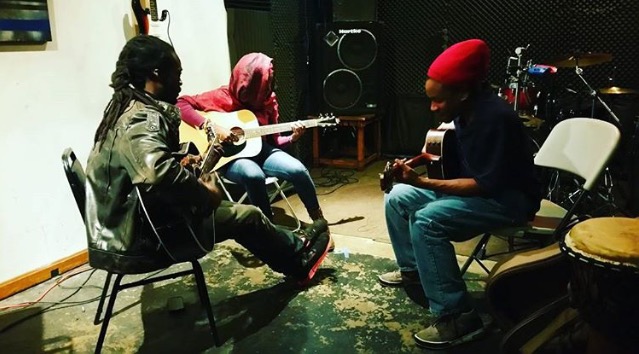
Mousai’s weekly gatherings started as weekly impromptu jam sessions, but transformed into the basis for a thriving creative economy.
Early on, a cadre of DC’s leading young musicians came on board to help teach. Obie Gereau taught keys and theory; Dante Pope taught voice, theory, and drums; and Ajene Harley taught guitar. One of the first guitar students was a local MC named Dior Ashley Brown.
Brown heard about the classes from her friend Ziggy who heard about them from her friend DJ Native Sun. She was no stranger to musical spaces as a graduate of the Duke Ellington School of the Arts, DC’s famed performing arts high school. Before Mousai, Brown had taken a number of music lessons throughout the city. “I was always in and out of somebody’s class until the point I couldn’t afford it.” She relied on Groupon and took classes until the deal ended, at which point she would have to stop attending. Aside from cost, Brown was searching for a space where she could both learn guitar and build community with like-minded people. Walking into her first class at Mousai, she knew she had found what she was looking for. “The vibe was just – it was spiritual for me.”
The white house on Evarts Street grew into a popular meetup for local artists. The door usually remained unlocked. “People would come in at any time of day,” Jones remembered. “Three o’clock in the morning the door would be open and someone would walk through like, ‘I thought ya’ll were jamming!’ and we’d all be in there jamming. So it was just that type of atmosphere.”
The Tuesday music lessons turned into all night jam sessions, attracting the cream of the crop of local hip hop, soul, and jazz musicians. Maimouna Youssef, Tamika Love Jones, and the CooLots were there. It was an informal network of peer-to-peer knowledge sharing that operated outside of the confines of the traditional economy. “While we were in those early stages it was a value exchange rather than a monetary exchange,” Jones shared. “And people found value in having a creative space in which to collaborate with other artists.” This reinforces Dr. Nembhard’s belief that the next economy must move beyond the price system. “Of particular importance,” she explains, “is the fact that resources are not solely financial. It’s not just about market relationships.” From the beginning, this has been a core value in the Mousai House culture.
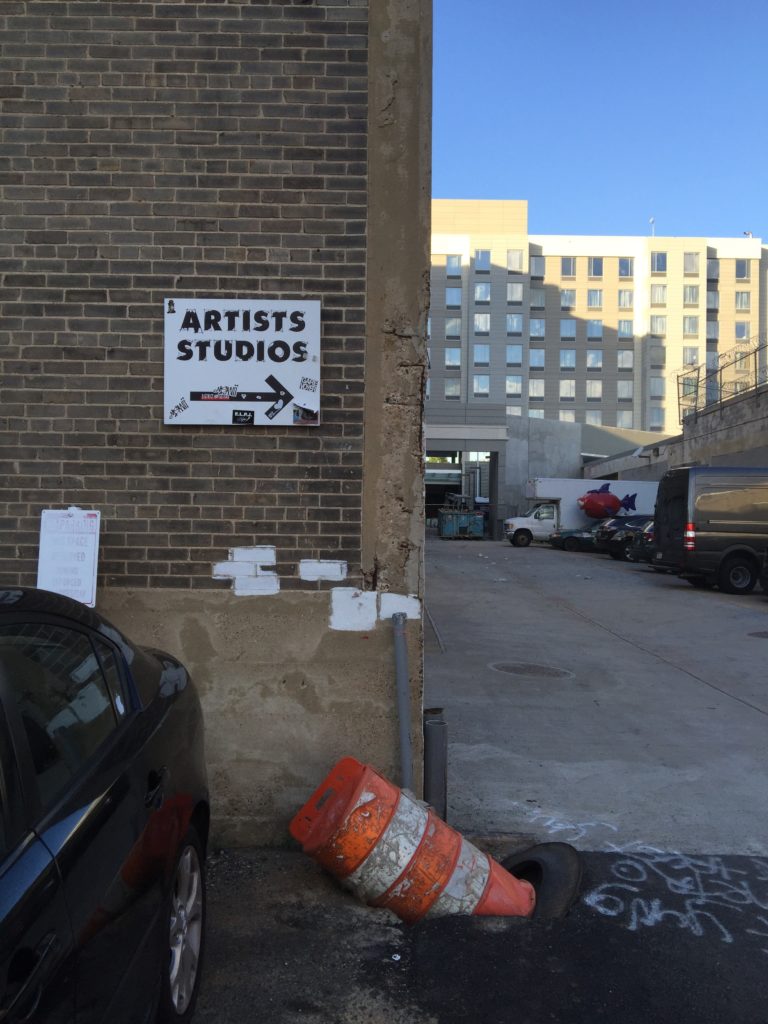
One of the last remaining arts warehouses in DC, the Union Arts building is slated to close in Spring 2017 to pave the way for a boutique hotel.
The Mousai House had become a music school, a performance venue, a studio and a community center all-in-one. Social media was peppered with flyers for events and classes. What started as a hobby had evolved into something much more. But there was one small problem: the little home on Evarts Street was a rental, and the owner was returning back to the United States from the Peace Corps. Their lease wasn’t going to be renewed.
Ownership is a recurring theme in both the Mousai House story and the history of Black Washington. For generations, restrictive covenants, redlining, and race-based housing policies limited ownership opportunities for African-Americans in the district. Similar policies and practices in commercial real estate created the same dynamic. Collective ownership is a cornerstone of the next system Dr. Nembhard imagines. Not only should real estate be affordable and cooperatively owned; but ideally, it would also be completely decommodified.
The strong personal relationships and professional network that emerged from the Tuesday night sessions produced some leads for a new space. “Right when the lease was coming to an end one of my guitar students, Aaron Jackson, hit me up on the phone and said, ‘Hey, you remember the old Warehouse Loft?,’” Jones recalled. They discussed a potential opening at Union Arts, a DIY arts space which had taken over the building formerly occupied by the infamous Warehouse Loft parties. There was indeed an opening, and two weeks later the Mousai House relocated to 411 New York Avenue NE.
The goal was to develop a space for artists that was both equitable and sustainable. It became clear that that would require some major systemic changes.
In many ways, the move was a good thing. The partnership with Union Arts meshed together artistic communities and created opportunities for new collaborations. The move also triggered a deeper exploration of the flaws in DC’s creative economy and generated lots of discussion around alternatives. The goal was to develop a space for artists that was both equitable and sustainable. It became clear that that would require some major systemic changes. “It would require a re-construction of the arts scene as it’s currently built,” Jones explained. “Currently it’s built without artists understanding business because they don’t learn that at Howard [University]. They learn how to be better at guitar, if you majored in guitar, but they don’t teach you anything about how to get gigs, how to talk to venues, how to know your worth, how to hustle, how to get your music out there. They don’t teach you any of that. So it would have to change from the education at its foundation. And it would have to change in the mindset of people.”
Education is central to cooperative economic development. Dr. Nembhard envisions a society where we “require cooperative and solidarity economics literacy from kindergarten to college.” This would happen both formally and informally, both inside and outside of traditional educational institutions. Dr. Nembhard explains that in order for a cooperative solidarity commonwealth to thrive, “we must all know and understand cooperatives and the solidarity economy better than we understand capitalism.”
Dr. Nembhard explains that in order for a cooperative solidarity commonwealth to thrive, “we must all know and understand cooperatives and the solidarity economy better than we understand capitalism.”
The Mousai House is an example of peer-led informal cooperative education. Together they’re developing a shared analysis of the current creative economy. “I love the story of the jazz musicians in the city because it’s literally what’s happening all over the country; but it’s here more than anywhere else,” Jones shared. “They’ll go to school, they have forty grand in debt, they get out and now they have to fight other just as talented jazz musicians – Howard puts out a slew of them, Duke Ellington puts out a slew of them – for a hundred dollar gigs a head. You practice, you rehearse, and then you’re playing for tips at a coffee shop. The whole band splits a hundred dollars.”
After Mousai took off in its first few years, Jones left his job to help create a structure for the organization so that it could continue. In order to help cover costs for the new space, Mousai developed a membership structure. Monthly memberships range in price from thirty to fifty dollars. The basic membership includes access to a shared work space, entrance to the Tuesday night classes and the jam sessions that follow, and discounted tickets to the concerts that happen on the last Saturday of each month (past performers include the legendary hip hop icon Bahamadia and the prolific LA-based musician Georgia Anne Muldrow). Resident artist members also get discounted studio time, and access to other resources and support.
The membership structure helps Mousai artists pool their resources to maintain affordability and cover the shared costs of the space. And it’s just the beginning of a larger vision of a cooperatively-owned artist incubator.
From the time the Mousai House arrived at Union Arts, there were murmurs that the building could be sold at any moment. The warehouse had been on the market since 2012. In January 2016, Mousai and the other artists at Union Arts received notice that the building had been sold to developers and was slated to become a boutique hotel. They had less than nine months to prepare for their impending eviction.
For Mousai, lightning had struck twice. They were once again facing displacement, this time from one of the city’s last remaining independent arts spaces. Instead of simply packing their bags, Mousai joined forces with Union Arts, the Nomad Yard Collectiv and over 100 artists to form the Artists Union. Using the social media hashtags #SaveDCArts, #iWillNotBeMoved, and #aGentrifiedDC, the artists banded together in a David and Goliath fight against the developers.
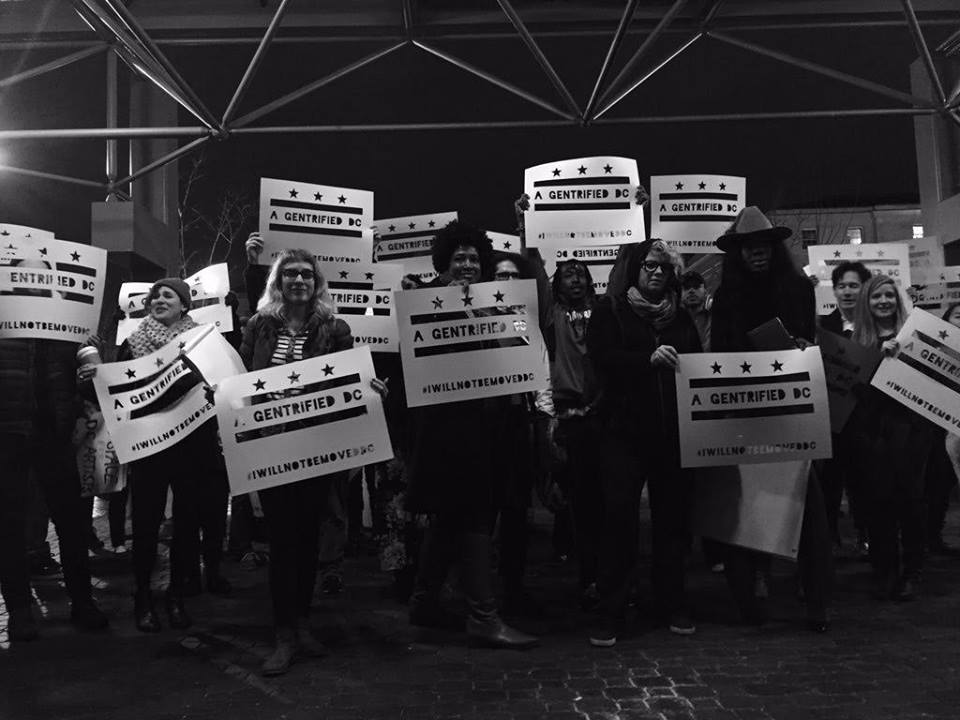
Artists and community members hold a demonstration outside of the DC Zoning Commission’s hearing on the sale of the Union Arts building, home to Mousai House and dozens of other arts spaces.
Dr. Nembhard insists on the correlation between cooperative membership and civic participation. “The theory of change behind this model of a cooperative solidarity commonwealth is that the more people that practice economic democracy, collective ownership, and economic transparency, the more they will come to expect to see these practices in the rest of their lives.” The relationships that Mousai members were able to create through years of music lessons and jam sessions extended beyond music. They had now entered the political arena. In a photo on the Artists Union’s Facebook page, Dior Ashley Brown is standing front and center outside of a DC Zoning Commission Hearing where over one hundred artists showed up to demand that the city act to stop the displacement of artists. Ironically, in the developer’s proposal for the new hotel, they claim they will “provide desperately needed art studio and gallery space for local residents and students.”
CulturalDC, a DC-based non-profit, is partnering with the developer to manage the arts spaces in the building. Two floors of the eleven-story hotel will house eight artist studios, a gallery and an art classroom. According to existing tenants, this will provide space for only a fraction of the number of artists that currently utilize the space.
These plans highlight the urgency of Mousai’s vision for a new creative economy. Art and arts spaces must be cooperatively owned by artists. Dior Ashley Brown explained, “I come from generational ownership. My granddaddy had a bike shop at 14th and V. We do want ownership. Now we’re getting more strategic.” She adds that their primary goal is to maintain affordability and accessibility.
“It just goes back to the basics of what we had at the house: The bartering system,” Gaje Jones explains. “You know what, we’ll forgo your membership for this month if you can do some bass classes for us, or if you can do this for us. I got a member who really wants to learn Pro Tools, can you give him some one-on-one instruction twice a week? And the value isn’t placed in monetary terms, it’s placed in relationships; because now those two people are working together on a new project. Real talk – this is actual, not hypothetical, this is what’s happening. Two DJs are linking up, one just wanted to learn Ableton but now they’re producing stuff together. We’re developing relationships. We’re developing bands like Redline Graffiti that started at Mousai.”
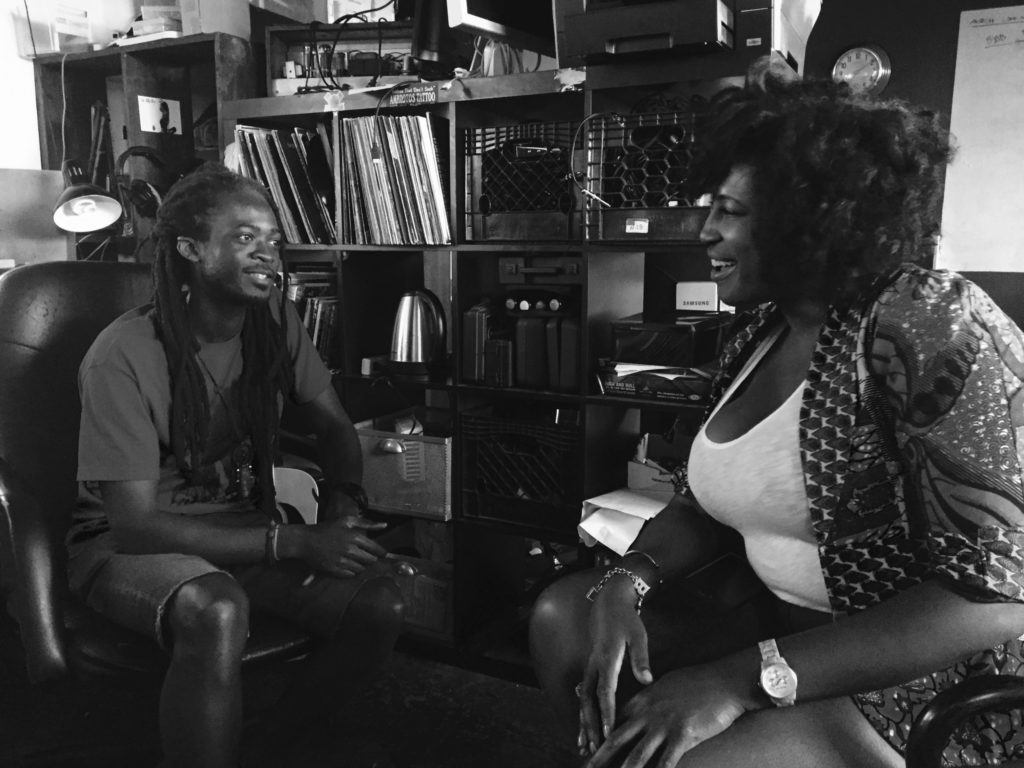
As a creative cooperative, Mousai House has built itself not just on economic solidarity, but also on developing meaningful and transformative relationships among community members.
In the end, the story of Mousai is not a story of the buildings they lost. It’s the story of the relationships they built. It’s the story of a community that emerged from informal Tuesday night music lessons that ultimately shaped an era of DC music. The artists of Mousai are continuing to shape their vision for a self-sufficient, self-determined artist-led cooperative incubator. Cooperatives like these are central to the next system imagined by Dr. Jessica Gordon Nembhard; a cooperative solidarity commonwealth where “surplus, or profit, is shared in equitable ways, through democratic decision making, and used for the common good.” In this system, “risks are collectivized, skills are perfected, learning is continuous, and economic practices are sustainable (both ecologically and from a business point of view), bringing collective prosperity.”
The cooperative that Mousai envisions may not be housed in their current home at the Union Arts warehouse, but with a confident hopefulness for the future, Dior Ashley Brown explains: “we want people to believe that Mousai can happen anywhere. That this essence, this family can exist. That the feeling of it exists with us.”
____________________________________
Jennifer Bryant is a DC-based writer, organizer and radio host. She is a founding steering committee member of Cooperation DC (a project of ONE DC). Cooperation DC’s mission is to expand opportunities for dignified employment and democratic ownership in low-income communities of color through the development of worker-owned cooperatives. Jennifer co-hosts Voices with Vision – a weekly radio show on WPFW 89.3FM – and produces Agenda 2016, the station’s national elections coverage.
Go to Original – thenextsystem.org
DISCLAIMER: The statements, views and opinions expressed in pieces republished here are solely those of the authors and do not necessarily represent those of TMS. In accordance with title 17 U.S.C. section 107, this material is distributed without profit to those who have expressed a prior interest in receiving the included information for research and educational purposes. TMS has no affiliation whatsoever with the originator of this article nor is TMS endorsed or sponsored by the originator. “GO TO ORIGINAL” links are provided as a convenience to our readers and allow for verification of authenticity. However, as originating pages are often updated by their originating host sites, the versions posted may not match the versions our readers view when clicking the “GO TO ORIGINAL” links. This site contains copyrighted material the use of which has not always been specifically authorized by the copyright owner. We are making such material available in our efforts to advance understanding of environmental, political, human rights, economic, democracy, scientific, and social justice issues, etc. We believe this constitutes a ‘fair use’ of any such copyrighted material as provided for in section 107 of the US Copyright Law. In accordance with Title 17 U.S.C. Section 107, the material on this site is distributed without profit to those who have expressed a prior interest in receiving the included information for research and educational purposes. For more information go to: http://www.law.cornell.edu/uscode/17/107.shtml. If you wish to use copyrighted material from this site for purposes of your own that go beyond ‘fair use’, you must obtain permission from the copyright owner.
